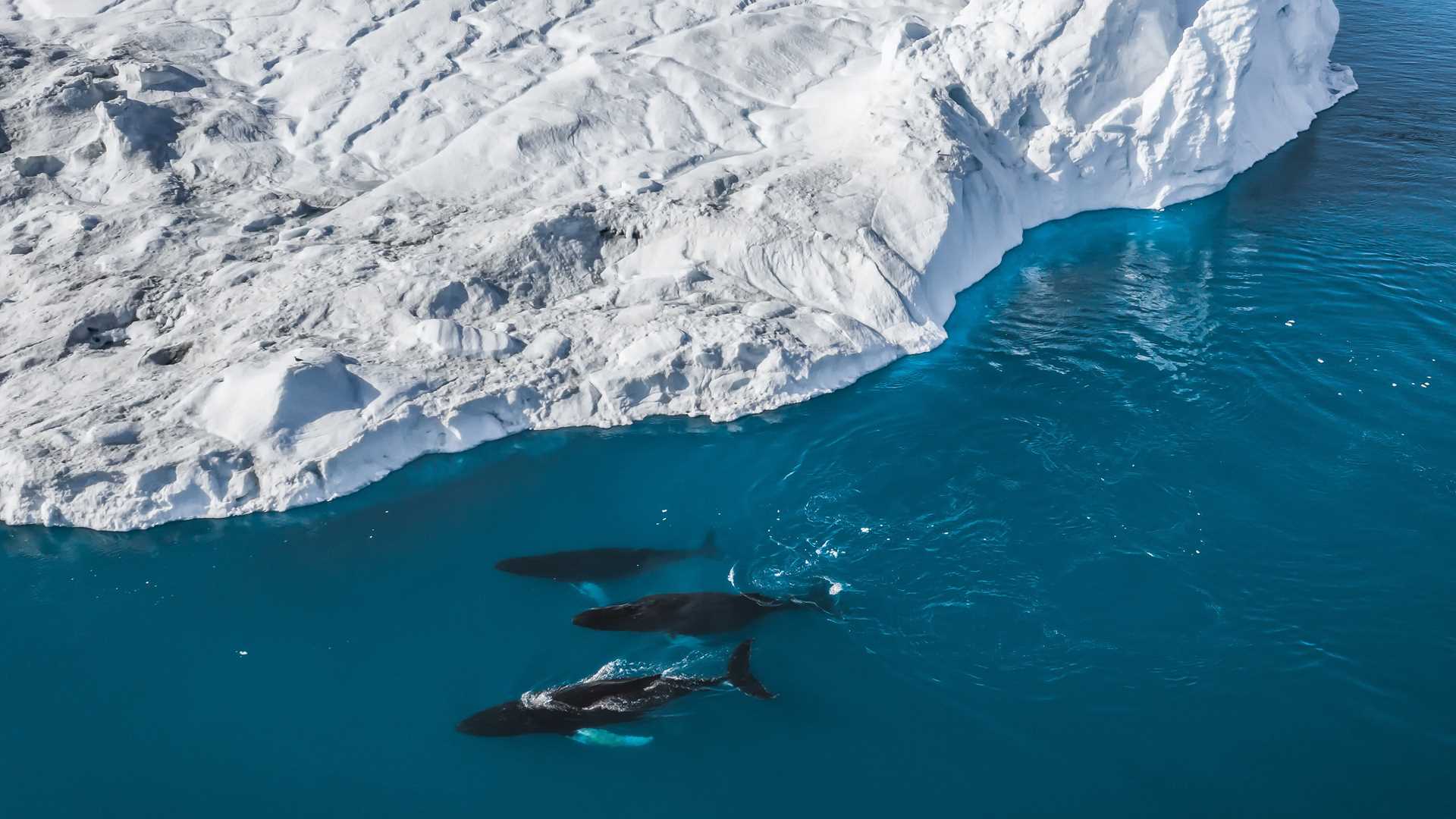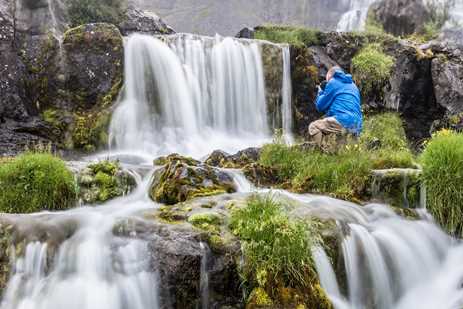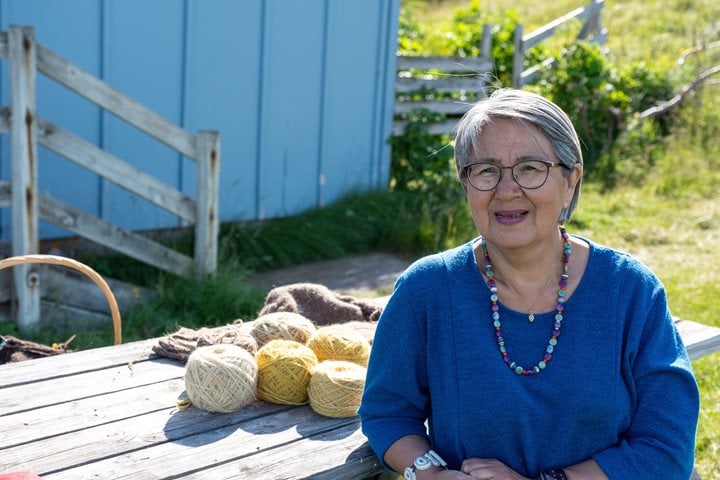Call +1.800.397.3348 or contact your travel advisor
The vast, icy waters at the top of the world are the ideal place for Arctic whale watching cruises. You can spot more than a dozen different species of whales in the Arctic, including the friendly white beluga, the elusive narwhal, and the largest creature on Earth, the blue whale.
If you’d like to spend next summer whale watching, consider joining Lindblad Expeditions-National Geographic on a voyage to the Arctic. You can whale watch from the bow of our small ships, witnessing orcas on the hunt and breaching humpbacks, while learning all about cetaceans from our shipboard experts.
World-class naturalists join every departure, sharing their wealth of knowledge about whale biology, migrations, and behaviors. They’ll be by your side on whale watching expeditions, using their expertise to increase the odds of a sighting. Sometimes, you may even travel with top whale scientists who are aboard to work on their latest research.
Here, we tap into our network of experts—and our decades of experience sailing the icy waters of the far north—to share the ins and outs of whale watching in the Arctic.
Learn about luxury Arctic cruises and Arctic cruise costs.
Where to See Whales in the Arctic
“The quick answer” to where and when to see whales on an Arctic expedition, according to Lindblad Expeditions-National Geographic naturalist and whale biologist Conor Ryan, is that “there are species of whales in different areas of the Arctic at all times of year.”
Considered by some to be the best place to whale watch in the world, the Arctic is home to resident populations of some whale species, as well as migratory populations that feed in these northerly nutrient-rich waters before heading south to calf.
Some regions of the Arctic are known for larger populations of certain species, but no matter which region you cruise, the odds of seeing whales are very high.
For example, the blending of cold and warm ocean currents around Iceland brings abundant fish and krill that attract more than a dozen species of whales, from minke and humpbacks to orcas and porpoises.
If you’re most interested in spotting the notoriously elusive narwhal, book a tour to the Canadian Arctic, Ryan advises, who adds that his best narwhal encounters have always been over in that region.
He notes that narwhals have been spotted to a lesser extent in Greenland and are seldom seen in Svalbard. “Basically, the further west and north you go, the better chance you have of seeing narwhals.”
“Beluga whales,” says Ryan, “are found across the region at all times of year.” Adding that “we can see them quite close to shore as we’re cruising along the coastline. Oftentimes people think you have to be on a boat to go whale watching, but that’s not true when you’re talking about beluga whales—they’re quite comfortable in shallow water.”
Antarctica is another world-class whale-watching destination. Find out about the similarities and differences of polar travel in the Arctic vs. Antarctica.
Thinking about booking an Arctic cruise? Learn how to get to the Arctic.
Whale Watching in Svalbard and the Norwegian Arctic
Whale watching in Norway, and particularly Svalbard whale watching, is an often unexpected highlight of an Arctic expedition. A variety of whales can be seen, sometimes in the pack ice of a remote area, but at other times they swim so close to shore that they can be observed from the streets of Longyearbyen, the world’s northernmost settlement.
When Can You See Whales in Norway?
“On the coast of Norway, you’d see minke whales throughout the summer; that’s a given,” according to Ryan. “Killer whales are quite regularly seen up coastal Norway as well.”
“When you get up to Svalbard, probably the highlight whale there is the blue whale. Even in Longyearbyen, which is where the ships set off from, I’ve seen blue whales within an hour of leaving the pier. They’re quite regularly seen in Svalbard in the mouths of the fjords.”
Whale Watching in the Northwest Passage
Sought after for generations by intrepid explorers from around the world, the Northwest Passage is the sea route running through the Canadian High Arctic that connects the Atlantic and Pacific oceans. It is also a habitat for orca, beluga, and bowhead whales; and, notably, the Northwest Passage is where 75 percent of all the world’s narwhals reside.
When Can You See Whales in the Northwest Passage?
In the summer months, the ice in the Northwest Passage retreats enough to open water channels so that expedition ships can navigate this legendary waterway and encounter whales.
Best Places to Whale Watch in Canada
Surrounded by the Atlantic, Pacific, and Arctic oceans, Canadian waters are home to around 30 different species of whales. Vancouver Island is known for orcas, Churchill for belugas, and Nunavut for narwhals—but with such a large whale population, there’s a good chance of spotting one in whichever part of Canada you choose to explore.
When Can You See Whales in Canada?
The summer—particularly July and August—is generally best for whale watching in Canada. However, in temperate regions like British Columbia, some species can be seen year-round.
In addition to beluga and narwhal, Ryan says that in his opinion, “The highlight species for Canada would be bottlenose whales.” Describing them as looking like oversized dolphins, he says, “they’re quite unusual, really beautiful creatures.”
Whale Watching in Greenland
The icy waters around the world’s largest island are home to 15 species of whales. Although not frequently seen, beluga and narwhal are permanent residents, while blue whales and orcas are among its migrant species.
When Can You See Whales in Greenland?
There are whales year-round in Greenland, but summer is when the ice shelf melts enough for expedition ships to travel into the country's spectacular fjords to observe wildlife.
All summer long, the highlight species in Greenland is the humpback whale, according to Ryan, who says you can see them “close to glaciers and sheltered waters.” Minke whales are also regularly spotted.
In addition, “If you’re doing long crossings, like going from Norway across to Greenland, you could see fin whales—the second biggest on the planet—as well as pilot whales off East Greenland.”
What Whales Will I See on an Arctic Cruise?
Aboard an Arctic cruise, you will learn more about what whales live in the Arctic. You can find 17 species there: both baleen and toothed whales, and a mix of resident populations and migratory animals that feed in the productive Arctic waters before returning south to give birth.
Below we highlight five of the Arctic’s most fascinating cetaceans: belugas, narwhals, and bowhead whales, which inhabit the Arctic’s icy waters year-round, and gray and humpback whales that migrate great distances to and from the region.
Prepare for your Arctic whale watching adventure—find out what Arctic clothing and gear to pack.
Beluga Whales
One of the smallest and most expressive whale species, belugas are quickly recognizable thanks to their white color and bulbous forehead. Ranging between eight-and-a-half and 22 feet long, they lack a dorsal fin, which makes it easier for them to travel under ice.
Because they are spread throughout the various regions of the Arctic, beluga whale watching tours are far ranging. These sociable cetaceans can be found both in salt and freshwater, along coastlines, and in bays and rivers.
If you come across a pod, you won’t just see them, you’ll hear them. Their vocalizations, which range from clicks and chirps to hums and whistles, inspired their moniker “the canary of the sea.”
Although they live year-round in the Arctic, many beluga populations migrate to the region’s southern reaches when sea ice forms, returning north to feed when the ice breaks up in spring and summer. They feed on salmon and crab as well as other fish and mollusks and can weigh up to one-and-a-half tons.
Narwhals
Beluga and narwhal are related and share similar attributes like their size and migration patterns in Arctic waters. Each species also has a distinguishing feature: Belugas are instantly recognizable for their striking white skin, while narwhals are known for their long spiraled “horns.”
But that “horn” isn’t a horn at all—it’s actually a tooth that erupts from the mouth of the males and can grow up to 10 feet long. Some males have two tusks, and although it’s very rare, about 15 percent of females also have one.
This twisted tusk, coupled with the fact that they are hard to spot, has earned narwhals the name “unicorn of the sea.” Unfortunately, this elusiveness means that spotting these creatures on narwhals tours is never guaranteed.
Because they can dive deeper than a mile and spend time far out at sea, they’re likely nearby even if you can’t see them. “Although we’re always doing our best to see them, they’re very, very skittish and they’ve learned to be wary of boats,” Ryan explains.
These incredible creatures can grow to 17 feet long and weigh up to 4,200 pounds, feeding on fish and crustaceans like halibut, squid, and shrimp.
Bowhead Whales
Some of the largest animals on the planet, bowhead whales can grow up to 60 feet long and weigh as much as 100 tons.
With blubber insulation measuring more than one-and-a-half feet thick—the thickest of any mammal—they live in Arctic waters year-round and use their reinforced skulls and enormous mass to break through dense ice.
On bowhead whale watching tours, look for a double hump, no dorsal fin, and a curved white mouth. The rest of the body is black, although sometimes they also have a light patch at the base of their tails.
While many whales head south for the winter, bowhead whales do the opposite. According to Ryan, “in Svalbard, the bowhead whale comes down in the spring and heads north in the winter into the depths of the ice.”
They filter enormous amounts of krill and plankton through their baleen and are thought to be some of the world’s longest living animals. Scientists know that they can live to age 100, and there’s evidence that some have lived for 200 years.
Gray Whales
Gray whales are better known for calving in the warm, shallow waters of Baja California. From there, they embark on the longest known migration of any species, traveling 12,000 miles round-trip to the Bering and Chukchi seas between Alaska and the Russian Arctic.
Measuring 40-50 feet long and weighing 30-40 tons, gray whales sport multiple white patches made up of barnacles and lice that attach to their slate gray bodies. On gray whale watching cruises, also keep an eye out for their dorsal hump. Instead of a dorsal fin, they have a hump followed by smaller bumps called knuckles that run to their tail flukes.
Unlike other baleen whales, they are bottom feeders and scoop up shrimp-like amphipods and other invertebrates from the sea floor, filtering them through their baleen plates.
Humpback Whales
Measuring up to 62 feet and weighing as much as 53 tons, humpback whales are perhaps the best known of all cetaceans. Since they live in all of the world’s oceans, humpback whale watching expedition cruises are possible in a variety of areas.
Although humpback whales are slow swimmers, they cover more distance than most other migratory animals. Leaving the Arctic in the fall, these majestic whales will travel thousands of miles to mate and give birth in warm waters, and then return in summer to delight guests with their acrobatic breaches and fin and tail slapping.
Humpbacks are often seen in pods and recognized by the distinct hump on their backs, bumps on their faces, long flippers, and white markings that are unique to each individual.
These whales take in about 5,000 pounds of krill, plankton, and fish every day, straining the seawater through their baleen plates. They are also known for their “songs”—vocalizations that travel for miles across the sea, but can’t be heard above water.
The ships in the Lindblad Expeditions-National Geographic fleet are equipped with hydrophones, and in whale-rich waters, our undersea specialists may drop them beneath the waves so guests may listen in on these fascinating vocalizations.
Our Arctic expeditions offer many opportunities to observe a range of whales, and guests should constantly have their binoculars at the ready, Ryan says.
“We’re always looking for the kinds of sightings that lend themselves to stopping the ship, but sometimes it’s just fleeting glimpses, and we might lose them in the ice, so we always encourage guests to keep their binoculars around their necks.
“I always bring mine to the dining room because the views on the ships are incredible. You’re always near a window, and there’s always a possibility of seeing something on short notice or unannounced,” he says.
“Also, put your time in on the ship’s Bridge—it’s a lovely environment to be in anyway — and you’ll always be rewarded.”













